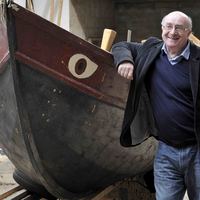- Maritime Archaeology, Ancient Navigation, Underwater Archaeology, History of Technology, Ancient Shipwrecks, Nautical Archaeology, and 35 moreMediterranean Underwater Archaeology, Maritime History, Harbour Archaeology, Ancient Shipbuilding, Dendrochronology, Technical History, Archaeology of Mediterranean Trade, Ancient technology, Ancient Seafaring, Mediterranean archaeology, History of Science and Technology, Egyptian Archaeology, Shipbuilding, Naval Architecture (History), Experimental Archaeology, Red Sea, Archaeology, Egyptology, Naval Architecture, Shipwrecks, Ancient Ports and Harbours, Naval History, Mediterranean, Maritime and Nautical Archaeology, Roman Archaeology, Economic History, Ancient Ships, Classical Archaeology, Greek Archaeology, History Of Technology (Technology), Ancient Technology (Archaeology), Ethnoarchaeology, Wood Technology, Ancient Trade & Commerce (Archaeology), and Historiographyedit
Research Interests:
Research Interests:
Research Interests:
Research Interests:
Research Interests:
Research Interests:
Research Interests:
Research Interests:
Research Interests:
Research Interests:
Research Interests:
Research Interests:
Research Interests:
Research Interests:
Research Interests:
In addition to the article "Transition from Shell to Skeleton in the Ancient Mediterranean" (IJNA 41-2, 2012), some additional remarks concerning the Romano-Celtic tradition of shipbuilding, the shipwrecks Conques of the Salins and Dor... more
In addition to the article "Transition from Shell to Skeleton in the Ancient Mediterranean" (IJNA 41-2, 2012), some additional remarks concerning the Romano-Celtic tradition of shipbuilding, the shipwrecks Conques of the Salins and Dor 2006 and "Sulle origini della carpenteria moderna".
Research Interests:
Research Interests:
Research Interests:
Research Interests:
Research Interests:
Research Interests:
Research Interests:
Research Interests:
Research Interests:
If many inventions are anonymous, the authors of some exploits are well known. This is the case of Archimedes who was responsible of the launching of the Syracusia, the largest ship of his time, whose success is probably related to his... more
If many inventions are anonymous, the authors of some exploits are well known. This is the case of Archimedes who was responsible of the launching of the Syracusia, the largest ship of his time, whose success is probably related to his theory of « floating bodies »
Research Interests:
The kelenderis Ship (5th c. AD) provides the oldest evidence of a settee sail (or Eastern lateen sail) belonging to the lateen sail family.
Research Interests:
Research Interests:
Research Interests:
Research Interests:
Research Interests:
Research Interests:
Research Interests:
Research Interests:
Research Interests:
Research Interests:
Research Interests:
Research Interests: History of Science and Technology, Maritime Archaeology, Nautical Archaeology, Mediterranean archaeology, Archaeology of Mediterranean Trade, and 5 moreAncient Shipwrecks, Shipbuilding, Ancient Seafaring, Merchant Shipping/Maritime Economics/shipbuilding/Mediterranean/Shipowners/Maritime Trade, and Maritime trade
Research Interests:
Research Interests:
Research Interests:
Research Interests:
Edited by Patrice Pomey, this special issue is devoted to the most relevants discoveries in nautical archaeology of these last years
